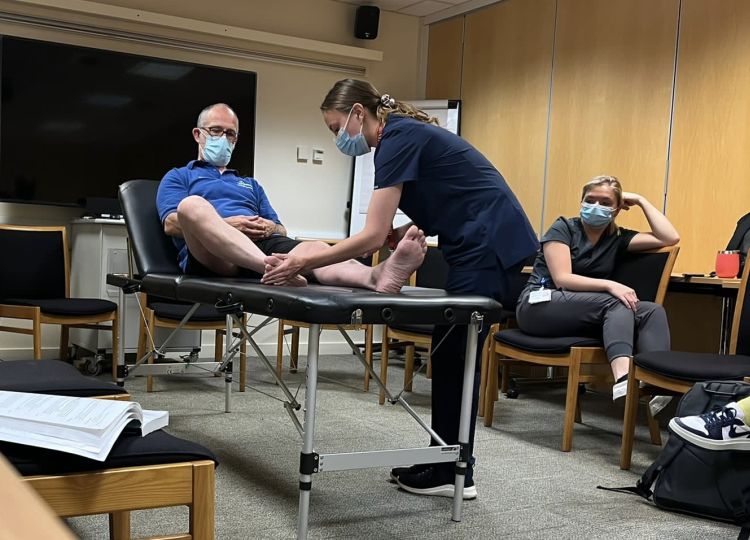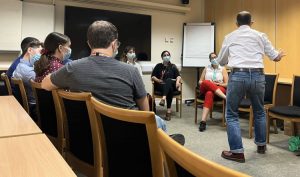
Meducate Academy were recently invited down to The Drummond Education Centre West Suffolk Hospital to demonstrate the role of the ACE to a group of 1st and 2nd year Physician Associates. The vast majority of the day was spent taking the students through systems examination techniques. Many of the students requested that we discuss techniques dealing with challenging patients, building rapport and maintaining empathy under stressful conditions.
During my time as an ACE, I inevitably get asked these types of questions from both students and novice ACEs. Questions usually focus on:
- How do I deal with an angry patient?
- How do I deal with contentious issues?
- How do I deal with upset patients?
- How do I break bad news empathetically?
Although each situation may present with its own problems, there are a few rules you can abide by which will help achieve the desired outcome.
When we talk about communication, the phrase that always crops up is:
“How do I build rapport and create empathy in a challenging scenario?”
Sometimes, when you are under pressure to deal with (for example) an aggressive, angry patient, it’s not so easy. Stress will cloud your judgement, you will doubt your ability to communicate effectively. You may panic, or at worst display anger of your own!
The first thing you should do is acknowledge the person’s situation. Acknowledge how they are feeling. Begin by asking them for more information about the source of their anger and then listen! If they use words like angry, frustration, annoyed, upset, use their words when replying to them, for example:
“I can see that you are angry.”
“I can see that you are frustrated… How can I help?”
Do not interrupt the patient. Wait for a natural space that they will create. Recognise how they feel without judgement. You must then explore the situation that has caused the anger, the frustration. Get them to define and clarify what they mean when they say they are frustrated.
Listen – Listen – Listen.
Whilst you are listening, use minimal encouragers. These are little verbal or non-verbal cues to show the patient that you are listening. For example:
Nodding of the head.
Saying, “Mmmm.”
Saying, “Go on, or yes.”
When I say listen, you must actively listen and not wait for the patient to stop talking, so that you can throw in a question that has no relevance to the patient’s current situation.
New students have a list of things they must ask the patient. SOCRATES is one of them and of course there is ICE (Ideas, Concerns, Expectations). Whilst these are important to complete a consultation, use them in the context of the situation. This is a conversation, not a battle or a debate. Become a partner in the interaction.
Once you have found out what the source of the problem is, it is time to restate what the patient has said. You could even say: “Is that everything?” Restate what they have said and get acknowledgement. You are now both talking on the same page and you can now help them come to some sort of closure. You are thereby maintaining rapport.
 During any heated conversation, you must think about your body language. Do not be too defensive in the way you are sitting or standing. To a certain degree, you need to mirror some of their nonverbal language. If they are in an open posture, keep yours as open as possible. If their arms are crossed, cross your hands or maybe your legs. This is called micro-mirroring and is less obvious to the patient.
During any heated conversation, you must think about your body language. Do not be too defensive in the way you are sitting or standing. To a certain degree, you need to mirror some of their nonverbal language. If they are in an open posture, keep yours as open as possible. If their arms are crossed, cross your hands or maybe your legs. This is called micro-mirroring and is less obvious to the patient.
You may also notice that some patients use words that sound visual, auditory or kinesthetic. It’s important to listen for these types of words. Below are some examples of sensory language or phrases that are commonly used.
The patient might use words or phrases that describe their experience visually:
“It’s clear to me.”
“I see where we are going.”
“The future is bright.”
“Look at it this way.”
They might however talk about:
“Getting to grips with the situation.”
“Trying to get a handle on things.”
These are kinesthetic statements and again you must learn to listen for them and use similar types of language in your reply.
Finally, we have the auditory pattern:
“I hear what you’re saying.”
“You are not listening to me.”
“Does that click for you?”
Often, people will use one or more of these sensory based patterns when speaking. Mirror some of these patterns and you are on the way to creating trust and rapport. Using the patient’s verbal and nonverbal language is a powerful way to build trust and hence come to an agreement.
Finally, never jump in mid-sentence when your partner is speaking. Keep listening and if the patient pauses, wait a little longer as they may be reflecting on what they have said. I often tell a student to bite their tongue and count to five before speaking. Give the patient time.
It is your responsibility to find out what the patient is trying to say. If you don’t understand what the patient means, ask them, for example:
“Would you explain what you meant by that?”
“I’m sorry, that’s unclear. I’m not sure what you said. Can you help me understand?”
If you are a student PA reading this, use these ideas to generate powerful, meaningful conversations with your patients. If you are an ACE, these techniques are the tools of your trade, so it’s your responsibility to be aware of them. You need to help a PA student to recognise them too.
If you are a Clinical Educator and would like to take advantage of using ACEs as part of your clinical teaching, book now for a free consultation. Contact us via the form below or give us a call on 07870611850. Thanks again for reading this post.
